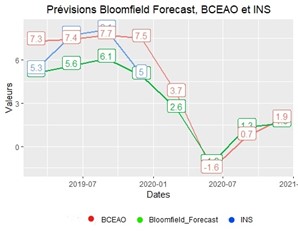For a long time, nowcasting was used to forecast very short-term weather conditions, before being applied to the economy in 2008. In this context, nowcasting makes it possible to monitor economic conditions in real time. This modern approach is relevant because one of the key measures of the current level of the global economy, namely gross domestic product, is only available in Côte d’Ivoire on a quarterly and annual basis, with a considerable delay in addition to the revisions it requires. As a result, economic agents whose activities require real-time information on the state of the economy are penalized. Bloomfield Forecast is a forecasting tool that bridges this gap for the benefit of investors, political authorities, central bankers and any other economic agent, by providing a signal on economic activity in real time.
Bloomfield Forecast photographs the economic conditions that influence financial flows, corporate earnings, and fiscal or monetary policy decisions. Bloomfield Forecast enables economic and financial analysts to follow the main publications to detect the first signals useful for their decision-making. The tool promotes sound investment decisions by facilitating decision-makers’ anticipation of economic conditions.
Bloomfield Forecast is based on statistical filtering techniques applied to a dynamic factor model. These techniques are very common in big data analysis, as they effectively summarize the information contained in large data sets through a small number of common factors. Bloomfield Forecast allows us to read information flows in real time and assess their impact on current economic conditions. The tool thus mimics the behavior of market players and professional forecasters, making forecasts that are constantly updated in response to unexpected developments in economic releases. The figure below shows forecasts from BCEAO (red), INS (blue) and Bloomfield Forecast (green). The INS and Bloomfield forecasts are relatively identical for the first and last quarters of 2019. The INS and BCEAO forecasts are closer in the second and third quarters of 2019. The difference in forecasts is minimal for BCEAO and Bloomfield Forecast in 2020.
These automated forecasts are relatively accurate and highly correlated with forecasts produced by institutions (notably the BCEAO and INS, and experts in the field of econometrics).

Bloomfield Forecast is of particular interest to public decision-makers and entrepreneurs wishing to enter the Ivorian market on the basis of the latest information on fluctuations in the economy. It would therefore enable commercial banks to diversify their portfolios more effectively in terms of the risks associated with different sectors of activity; public authorities, whose planning needs require informed assumptions, to facilitate the strengthening of economic sectors where necessary; BCEAO and other central banks to consolidate calculations and decision-making; and finally, development aid organizations to better direct their financing.

